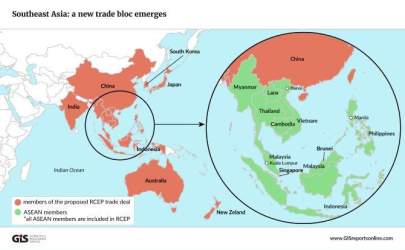Authoritarian Regimes Revive U.S. Alliances

An axis of aggressive authoritarian regimes—Russia, China, Iran, and North Korea—has revived the system of alliances America built after World War II and reminded Americans why we built this interlocking system of alliances in the first place. After more than a decade of U.S. policymakers dismissing allies as “free riders” and calling into question America’s commitment to allies, this is a welcome and unexpected turn of events.
History
Before looking at this revival of our alliance system, it’s important to spend a moment on the history leading up to the post-World War II web of alliances.
Most of us were taught that America was historically—even congenitally—opposed to alliances. President Washington’s farewell address, for instance, was laced with warnings about foreign entanglements. In fact, he used the words “foreign” and “world” 17 times in his valedictory—almost all of them in a negative light. “It is our true policy to steer clear of permanent alliances with any portion of the foreign world,” he declared, cautioning against “foreign alliances, attachments, and intrigues.” Echoing the father of our country, President Jefferson called for “peace, commerce and honest friendship with all nations, entangling alliances with none.”
Yet the historical record shows that the United States was engaged in entangling alliances right from the start. While we tend to think of hostility to foreign alliances as part of America’s DNA, it pays to recall that before his presidency, Ambassador Jefferson proposed a U.S.-European alliance to fight piracy and protect shipping. More significantly, Benjamin Franklin was dispatched to Paris in 1776 to negotiate and secure an alliance with France. Between 1778 and 1782, as a State Department history details, France “provided supplies, arms, and ammunition…troops and naval support…transported reinforcements, fought off a British fleet and protected Washington’s forces in Virginia.”
After the Great War, America retreated from the world stage for a generation. However, the attack on Pearl Harbor shattered the idea that the oceans could protect America, silenced those who argued that isolation was preferable to engagement, and revived America’s interest in alliances: Just weeks after Pearl Harbor, the U.S. organized a 26-nation alliance to wage a “common struggle against savage and brutal forces seeking to subjugate the world.”
In short, the notion that America disdained alliances and lived in blissful isolation up until World War II is a myth—as is the notion that the alliance system America built after World War II is no longer needed.
Our alliances serve as force multipliers, sources of moral and material support, layers of strategic depth, and outer rings of our own security. And far from entangling us in conflicts, our alliances have deterred great-power war and repeatedly helped us through the conflicts of the post-World War II world. After all, it wasn’t an alliance that pushed the U.S. into World War II, but rather an attack on an isolated outpost of an isolated America. And by building up a common defense, specifying clear consequences and clear commitments, and recognizing that America’s security is tied to other parts of the globe, the postwar alliance system surely helped prevent the Cold War from turning into World War III.
As Winston Churchill, a man who waged cold wars and hot wars, counseled, “There is only one thing worse than fighting with allies, and that is fighting without them.”
Threats
With Russia on the march, China on the rise, and Iran and North Korea putting our allies and partners on edge, America’s interlocking system of alliances is more important than at any time since the beginning of the Cold War—and is still key to preventing World War III.
In Europe—the very heart of the U.S.-led alliance system—Vladimir Putin’s Russia has laid siege to Ukraine; annexed parts of Ukraine and Georgia; issued military threats against allied governments in Norway, Poland, Finland, and Sweden; used chemical weapons to assassinate political enemies in Britain; and violated numerous arms treaties. Nor has Putin’s war on civilization been confined to European territory. Putin’s Russia has hacked and attacked the U.S. power grid; propped up regimes that gas (Syria) and starve (Venezuela) their own people; armed Taliban thugs waging war against the U.S. and other NATO peacekeepers operating under UN mandate; and routinely violated and/or threatened Japanese airspace and territorial waters.
In the Indo-Pacific—home to U.S. treaty allies Japan, Australia, South Korea, and the Philippines—Xi Jinping’s China has constructed, and militarized illegal islands, absorbed Hong Kong in violation of international treaties, and threatened to seize Taiwan. Xi’s regime has attacked democratic India; constantly violated Japanese waters (as many as 58 incursions per month); conducted a relentless cyber siege of the Free World; unleashed through incompetence a crippling global pandemic; expanded its nuclear arsenal and nuclear-strike capabilities; and is engaged in one of history’s largest peacetime military buildups. The PRC’s annual military expenditure has mushroomed by 517 percent since 2000.
Also lurking in the Indo-Pacific is Beijing’s Frankenstein monster North Korea. With its growing nuclear arsenal, spasms of missile tests, and unpredictable leadership, North Korea has put South Korea, Japan, and the U.S. on edge. In 2022, North Korea test-fired more than 90 missiles, including 23, on a single day.
Finally, in the Middle East, Iran is harboring al Qaeda’s new leader, Saif al-Adel. Iran continues its efforts to foment revolution by aiding rebel groups in Yemen and Bahrain; deploying troops to Iraq and Syria; bankrolling and training Hezbollah in Lebanon; and trying to destabilize moderate governments as far away from Iran as Morocco. Iran continues its drive to build a nuclear bomb, continues to attack commercial, and military vessels in international waters, and continues to target Americans. And as it supplies kamikaze drones to Putin’s army of criminals in Ukraine, Iran continues to wreak havoc outside its neighborhood.
Part two of this series will explore how the U.S.-led alliance system is responding to these threats.




